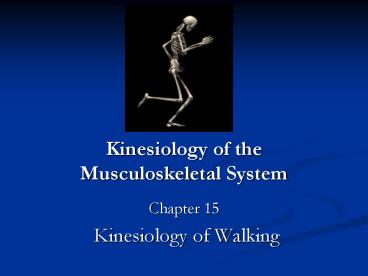Kinesiology of the Musculoskeletal System PowerPoint PPT Presentation
1 / 19
Title: Kinesiology of the Musculoskeletal System
1
Kinesiology of the Musculoskeletal System
- Chapter 15
- Kinesiology of Walking
2
Gait Terminology
- Gait Cycle the fundamental unit of walking
measurement in time or , from initial contact
(aka. heel strike or heel contact) of one foot
through the point when that same foot makes
contact with the ground again - Stride sequence of events taking place between
successive heel contacts of the same foot - Step sequence of events that occurs within
successive heel contacts of opposite feet
3
Gait Terminology (cont.)
- Stride length distance between two successive
heel contacts of the same foot - Step length distance between successive heel
contacts of the two different feet - Step width lateral distance between the heel
centers of two consecutive foot contacts
(normally 7-9 cm) - Foot angle degree of toe-in or toe-out
(about 7 degrees of toe out is normal)
4
The Gait Cycle
- Stance Phase (60 of gait cycle) from initial
contact to toe off of the same foot - i.e. Right stance phase is when right foot
is in contact with the ground and is supporting
weight - Swing Phase (40 of gait cycle) from toe off
to initial contact of the same foot
5
Subdivision of the Gait Cycle
- Divided into phases of stance and swing, and into
periods of single and double-limb support - 80 of the stance phase is taken up by single
limb support - 20 by double limb support
6
Subdivision of the Gait Cycle
7
Stance Phase Events
- Initial Contact (heel contact heel strike)
- Foot Flat marked by the instant the striking
foot lies flat (approximately 8 into gait cycle) - Mid-stance point where the bodys weight passes
directly over the supporting lower extremity
occurs during mid point of stance phase - Heel off (heel rise)- marked by the heel of the
stance foot leaving the ground (approximately 10
into gait cycle) - Toe off approximately 60 into stance phase
10 of the phase after double limb support
8
Swing Phase
- Early Swing from toe off to mid swing
- Mid Swing corresponds to mid stance of support
leg feet pass next to each other - Late Swing from mid swing to initial contact
9
Time Periods of Gait Cycle
- Stance Phase
- Loading Response
- Mid Stance
- Terminal Stance
- Pre Swing
- Swing Phase
- Initial Swing
- Mid Swing
- Terminal Swing
10
C of M Displacement
- Despite all of the lower extremity movement,
- C of M is only displaced, on average, 5 cm
vertically and 2 cm horizontally - The less the displacement, the more economical
the gait cycle
11
Sagittal Plane Kinematics
- Hip sagittal plane ROM is from -10 degrees
extension to 30 degrees of flexion - Knee joint flexion peaks after toe off full
extension never occurs in the normal gait cycle - Plantar flexion peaks at
- toe off
12
Horizontal Plane KinematicsInternal/External
Rotation
13
Walking Speed
- Walking speed may be the best and most functional
measure of an individuals walking ability speed
can be raised by either increasing stride or step
length, and increasing cadence - Normal Values
- Gait speed 1.37m/s or 3 mph
- Step rate 1.87steps/s or 110 steps/min
- Step length 72cm (28 inches)
14
Energy Expenditure of Walking
- The body attempts to conserve energy expenditure
by minimizing excursion of C of M, controlling
body momentum taking advantage of
intersegmental transfers of energy
15
Muscular Activity During the Walking Gait Cycle
16
Ground Reaction Forces
17
Path of Center of Pressure
- Initial Contact (heel contact) occurs at the
posterior or posterolateral aspect of the heel in
most walkers - IC can also occur at the midfoot or forefoot,
but less commonly - Following IC, the path of center of pressure
travels through the midline of the midfoot and
then deviates medially, towards the 1st or 2nd
toe - Toe Off can occur from the 1st or 2nd toe,
depending on anatomical or biomechanical
individualities - Variations of the path of C of P do occur,
possibly suggesting significant biomechanical
deviations - Variations of the path of C of P lend to
biomechanical inefficiency
18
Over Pronation
19
Gait Analysis Lab

